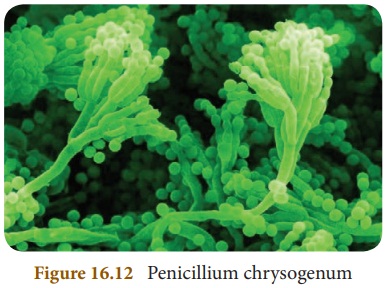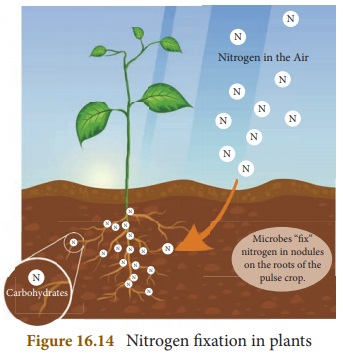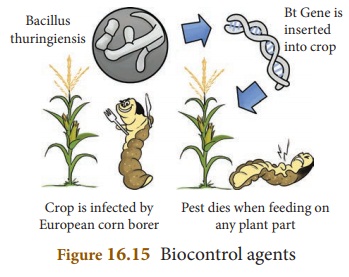Microorganisms | Chapter 16 | 8th Science - Uses of Microorganisms | 8th Science : Chapter 16 : Microorganisms
Chapter: 8th Science : Chapter 16 : Microorganisms
Uses of Microorganisms
Uses of Microorganisms
Microorganisms are useful in
different fields such as medicine, agriculture and industry. Some of them are
given below.
Medicine
We obtain antibiotics and vaccines
from microbes.
Antibiotics
The word ‘anti’ means ‘against’.
Antibiotic is a substance produced by living organisms which is toxic for other
organisms.

Sir Alexander Fleming was the first
person to discover the antibiotic penicillin in the year 1928. The antibiotic
penicillin was obtained from the fungi Penicillium
chrysogenum. It is used to treat diseases such as tetanus and diphtheria. The
antibiotic, streptomycin is obtained from Streptomyces
bacteria to cure various bacterial infections. Eg. Plague.
Vaccines
Vaccines are prepared from dead or
weakened microbes. Edward Jenner was the first person to discover small pox
vaccine. He coined the term vaccination. When the vaccine is injected to the
body of a pati ent, the body produces antibodies to fight against the germs.
These antibodies remain inside the body and protect from future invasion of the
germs. Therefore, vaccination is otherwise called as immunization.
Eg: MMR vaccine is given for
preventing Measles, Mumps and Rubella. BCG (Bacille Calmette Guerin) vaccine is
given for preventing Tuberculosis.
Agriculture
Natural
fertilizer
Microorganisms are called as
decomposers because they act upon degradable wastes. During the process,
nitrates and other inorganic nutrients are released into the soil, making the
soil fertile. This compost is called as natural fertilizer.

Nitrogen
fixation
Rhizobium
bacteria living in the root nodules
of leguminous plants enrich the soil by fixing the atmospheric nitrogen as
nitrates which are essential for the growth of plants. Some free living
bacteria in soil, like Cyanobacteria Nostoc can also fix nitrogen biologically.

Bio-control
agents
Microbes are used to protect the
crops from pests. Some of them are given below.
* Bacillus thuringiensis (Bt cotton) helps to control insects.
* Trichoderma (Fungi) helps to protect roots and controls plant
pathogens.
* Baculoviruses (Virus) attack insects and other arthropods.

Industry
Sewage
treatment
Aerobic microbes are allowed to grow
in the primary effluent during the secondary stage of waste water treatment.
These microbes consume the major part of the organic matter in the effluent.
Eg. Nitrobacter sps. In the anaerobic treatment of sewage Methanobacterium is
used.
Production
of biogas
Human and animal faecal matter and
plant wastes are broken down by anaerobic bacteria to produce methane (biogas)
along with carbon dioxide and hydrogen. These bacteria are called as
methanogens.
Production
of alcohol and wine
Alcoholic drinks are prepared by
fermentation process using yeast. Sugars present in grapes are fermented by
using yeast. Beer is produced by the fermentation of sugars in rice and barley.
Microbes
in retting and tanning
Flax plants are tied in bundles and
kept in water. Bacteria loosen the supporting fibres of the stem by acting on
the stem tissues. This process is known as retting. Linen thread is made from
these fibres. Eg. Pseudomonas aeruginosa.
In tanning industry bacteria act
upon the skin of animals and makes it soft and therefore it becomes pliable.
In daily life
Making
bread
Yeast is used in bakeries to make
bread and cakes. They are added to the dough to produce carbon dioxide which makes
the dough rise. Bread and cakes are soft due to carbon dioxide gas. Chlorella (green algae) which is rich in
proteins and vitamins is added to the dough to enrich the bread with nutrients.
Preparation
of curd and cottage cheese
Lactose in the milk gets turned into
Lactic acid by the action of Lactobacillus
(bacteria) . Therefore, milk becomes thick (curd) . It gives the sour taste.
When curd is processed cottage cheese (panneer) is obtained.
In
Human Intestine
* Lactobacillus acidophilus that lives in the human intestine helps
in digestion of food and fights against harmful disease causing organisms.
* E.coli bacteria living in human intestine help in synthesizing
vitamin K and vitamin B complex.
Microbes in Food
Process
Microorganisms commonly used for
food processing are yeast, bacteria, and moulds. Fermentation process which is
carried out by microorganisms results in the production of organic acids,
alcohol and esters. They help to preserve food and generate distinctive new
food products.
a. Food preservation
Two techniques are followed in food
preservation. They are:
* Traditional techniques
* Modern techniques
1. Traditional techniques
Fermentation, pickling, boiling and
sugaring are the traditional techniques followed in food preservation.
Fermentation
Fermentation is the microbial
conversion of starch and sugars into alcohol. It makes foods more nutritious
and palatable.
Pickling
Pickling is a method of preserving
food in an edible antimicrobial liquid. It is of two types: chemical pickling
and fermentation pickling.
In chemical pickling, food is placed
in an edible liquid that kills bacteria and other microorganisms. Eg. Vinegar,
alcohol, vegetable oil (pickling agents). In fermentation pickling, bacteria in
the liquid produce organic acid as preservation agent that produces lactic acid
due to the presence of Lactobacillus.
Boiling
Boiling liquid food items kill all
the microbes. Eg. Milk and Water.
Sugaring
Sugar is used to preserve fruits in
an antimicrobial syrup with fruits such as apples, pears, peaches, plums or in
a crystallized form, so that the product is stored in dry condition.
2. Modern techniques
Pasteurization
It is a process for preservation of
liquid food. This method was invented by Louis Pasteur in 1862. Milk is
preserved by this method. It is heated up to 70 ºC to kill the bacteria and it
is cooled to 10 ºC to prevent the growth of remaining bacteria. Then milk is
stored in sterilized bottles in cold places.
b. Food production
Probiotics
Probiotics are live food supplements
used in yoghurt and other fermented milk products. Eg. Lactobacillus
acidophilus and Bifidobacterium bifidum. These bacteria improve the microbial
spectrum in the gut and thus contribute to the following effects.
* Decrease the risk of colon cancer
* Decrease cholesterol absorption
* Prevent diarrheal diseases by increasing
immunity
Related Topics